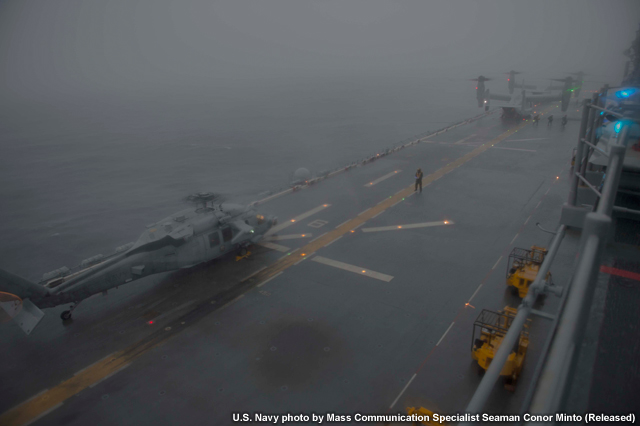Precipitation

Precipitation is considered as occurring at the ship if the fall is directly affecting any part of the ship, as detectable from the observation site. The predominant type and character of precipitation should be reported. Intensity should be expressed as light, moderate, or heavy and is defined with respect to the type of precipitation occurring, based on rate-of-fall for rain and ice pellets or visibility for snow and drizzle.
Table II-5-4, Table II-5-5, Table II-5-6, and Table II-5-7 of COMNAVMETOCCOMINST 3144.1E contain guidelines for estimating the intensity of precipitation based on visibility. The intensity can be determined based on rate-of-fall measurements or by using visual indicators, as summarized here.
| Intensity | Rate-of-Fall for Precipitation (Non-drizzle) | Physical Indicators (Rainfall) | Physical Indicators (Drizzle, Snow) |
|---|---|---|---|
| Light | trace to 0.10 inch per hour; max 0.01 inch in 6 minutes | individual drops easily seen, puddles form slowly, slow pattering to gentle roar, steady small streams may flow off decks | visibility => ⅝ statute mi, 0.55 nautical mi, or 1000 m |
| Moderate | 0.11-0.30 inch per hour; more than 0.01 inch up to 0.03 inch in 6 minutes | individual drops not clearly identifiable, spray observable, puddles form rapidly, swishing sound to gentle roar | visibility 5/16-⅝ statute mi, 0.25-0.55 nautical mi, or 500-1000 m |
| Heavy | more than 0.30 inch per hour; more than 0.03 inch in 6 minutes | rain falls in sheets, individual drops not identifiable, heavy spray observed on decks, sound like rolling drums or distant roar | visibility <= ¼ statute mi, 0.2 nautical mi, or 400 m |
Here are some example remarks statements for liquid precipitation type and intensity:
- -RA OCNL RA: occasional rain showers occurred
- SHRA: varying precipitation
During the occurrence and following the end of hail, measure the diameter of the largest hailstones in inches and fractions of an inch. Include the time of beginning, ending, or both to the nearest minute. Here is an example of how hail can be encoded in your METAR.
- GR 1/2: Hail 1/2 inch in diameter
The thunderstorms you viewed earlier are now 1.5 miles west of the ship and you can hear thunder. What action would you take? Choose the best answer.
The correct answer is b).
Thunderstorms need to be recorded in the weather observations when thunder is heard regardless of whether its precipitation is affecting the ship. Because the precipitation is not occurring at ship, the observation will not state what type of precipitation occurred or the size of any possible hailstones.
Significant changes in precipitation should also be reported. Significant changes involve the beginning or ending of hail, ice pellets, ice pellet showers, freezing rain, and freezing drizzle as well as changes in their intensity. The beginning and ending of other types of precipitation must also be reported, but changes from one non-ice type to another (e.g., rain to snow) need not be reported as a significant change. The following is an example showing a significant weather change as it would be reported in Remarks:
- TS E MOV E 5 KT HAIL END19
To encode precipitation on the observation sheet, report the start time, stop time, and the precipitation type.